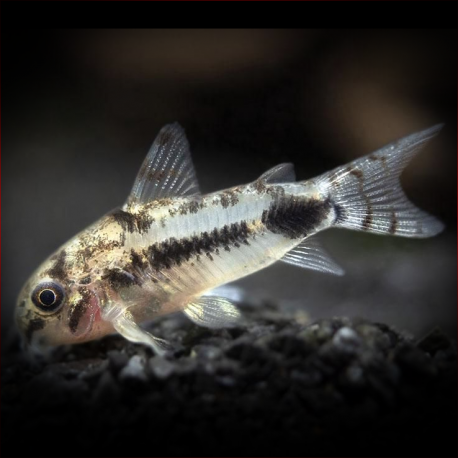More info
Datasheet
| Minimum Tank Size | 60 litres / 15.85 US gallons |
| Maximum Size | 3.5cm / 1.38inches |
| Temperature | 20°C / 68.00°F - 26°C / 78.80°F |
| Hardness | 2.02dgH / 36ppm - 10.03dgH / 179ppm |
| pH | 5.5-7.5 |
General Description
The Corydoras habrosus, commonly known as Salt And Pepper Cory, is a peaceful and gregarious species belonging to the Callichthyidae family under the order Siluriformes. These fish are also referred to as 'dainty cory', 'checker cory', 'Río Salinas cory', and 'Venezuelan pygmy cory' in the aquarium trade. They have a variable color pattern on their bodies and can be distinguished from similar species by the number and distribution of dark markings present.
Aquarium Setup
For optimal care, Corydoras habrosus should be kept in groups of at least 4-6 individuals, ideally 10 or more. The tank setup should include a substrate of fine sand or clean rounded gravel, with additional decor such as plants or driftwood for cover, providing a sense of security.
Behaviour
Corydoras habrosus are peaceful and social fish that prefer to be kept in groups. They tend to aggregate near submerged vegetation or structures like tree branches. These fish are facultative air breathers, occasionally rising to the water's surface to take in atmospheric oxygen.
Feeding and Diet
Being foraging omnivores, Corydoras habrosus accept a variety of foods, including sinking dried foods, small live, and frozen varieties such as chironomid larvae and bloodworms. A varied diet is essential for their optimum health, and they should not rely solely on leftovers from other tank inhabitants.
Reproduction & Dimorphism
Breeding Corydoras habrosus involves maintaining a ratio of males to females and providing conditions conducive to spawning. The females are usually larger and broader-bodied than the males. After spawning, the eggs can be removed and incubated separately until hatching, with the fry requiring small live foods for sustenance.
Habitat and Distribution
Native to the upper Río Orinoco basin in Colombia and Venezuela, Corydoras habrosus is typically found in left bank tributaries with slow water flow. They prefer lagoons, tributary streams, and inundated forest areas for habitat. The species occurs in the Llanos Orientales region, characterized by seasonal flooding that creates vast wetlands ideal for wildlife.

